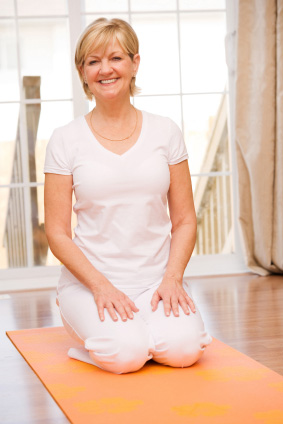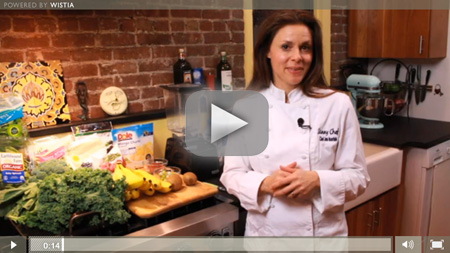 Want to find a way to relax and get a workout at the same time without investing in a pricey gym membership? Spend some time with yourself and start developing a home yoga practice.
Want to find a way to relax and get a workout at the same time without investing in a pricey gym membership? Spend some time with yourself and start developing a home yoga practice.
I still enjoy taking group yoga classes and learning from yogis who teach from different traditions, but I have a very strong home practice that I started over six years ago, when I was a culinary student and completely broke. Doing yoga at home helped to ease my sore legs from standing 10 to 12 hours a day on concrete floors and helped to reverse some of the repetitive motions, like holding a knife for hours at a time, that can be tough on joints and tendons and cause lasting injuries. But the best benefit to cultivating a focused home practice is to realize that you can take yoga with you anywhere you go and do it anytime.
Starting Your Home Yoga Sessions
You don’t have to be an expert to start, but it does help to be comfortable with the basics and have a general working knowledge of the beginners’ poses. There are many wonderful videos and DVDs on the market that you can use and even comprehensive free resources, like these demos from iyogalife.com to help you create your own routines.
Think about the best time for you to practice so that you can do it often. If you’re a procrastinator, then first thing in the morning might be ideal or if you’re a night owl maybe kick off the setting of the sun with a moon salutation series.
A Place to Practice
Find a space in your home where you can have enough room to move without knocking anything over and spread out your arms and legs. I do recommend using a mat, it helps to give you a softer surface to practice on and helps to keep you from slipping while you hold the postures.
If possible, find a room that is free of drafts, where you can close the doors to shut out potential distractions. I like to practice in the same place so that when I set down my mat, my mind starts to focus right away so I can begin my mental practice before even doing the first posture. Wear comfortable clothing and have tissue handy in case you get the sniffles. Treat the home practice with the respect and the same attention you would give a teacher and other students in a group class by resisting the temptation to answer your phone or leaving your spot until you are ready to conclude the practice.
Plan it Out
If you are still a beginner or haven’t been practicing that long, plan out your entire asana practice before you begin so that you will have a well-rounded routine to follow until you learn how to mix and match all the poses to tailor your own healing practice.
Start out with traditional sequences or this beginner’s flow, where the teachers begins in a seated posture to move on to sun salutations and standing poses. Then, you can tack on inversions, backbends, and twists that you can find under the beginner’s flow poses tab, finally ending with savasana or corpse pose.
As you become more knowledgeable about the poses’ effects and the relationships between poses, you can begin to create other, more varied sequences. No matter the length of your practice, always be sure to end with corpse pose, 15 to 20 minutes if you can. The relaxation at the end of your practice gives your body a chance to rest naturally, but also helps to “reset” the muscles so you won’t feel strained. Yogis believe that to relax at the end of the practice makes the changes to the body “stick” and integrates all the energy you’re expending back into the body, physiological as well as mentally.
Be a Regular
The best way to have a strong home practice is to do it often, even if you have to do a shorter routine. One of my favorite teachers, Gurmukh, often says when she’s teaching, “keep up”. Eventually, you’ll want to work up to a complete class, aiming to practice comfortably, without distractions, in your home for at least 45 minutes.
Don’t be discouraged when you first start out, it might take a few days or up to a year of practicing inbetween group classes to really get your mind and body comfortable to practice in a focused way in your own home.
Benefits of Having a Steady Home Practice
Strapped for cash for class? Just practice at home.
It’s pouring rain and you’re fighting a cold? Stay dry and practice at at home.
You’re work schedule has you traveling, away from your favorite yoga studio? You can do your own practice in the hotel room.
Regardless of what you actually do, your practice should be a reflection of being here right now. I like to dedicate my practice mentally to things I aspire too, more patience, more focus, whatever it is that is going on right now in the present as I sit on my mat.
Resources
Music – Using music in your home practice can be a great way to lengthen your practice and focus on the poses without always looking at the clock. Here are some of my all time favorites:
- Ever So Lonely – Sheila Chandra
- Krishna Das – Ring Song/ Jaya Siya Ram
- Sheila Chandra – Om Namaha Shiva
- Russill Paul – Om Namah Shivaaya
- Sting – The Book of My Life
- Sheila Chandra – Sacred Stones
- Deva Premal – Gayatri Mantra
- Sheila Chandra – Mecca
- Sheila Chandra – Bhajan
- Sheila Chandra – Lament of McCrimmon / Song of the Banshee
- Deepak Chopra – Music Inspired by the Love Poems of Rumi – Desire, No. 5: The Lover’s Passion
- Susheela Raman – O Rama
Books
Yoga books can be a wonderful resource to learn about Indian philosophy, mysticism, and deepen your existing physical fitness practice. Check out my collection of favorites, that I reference on a regular basis. If you are interested in learning yoga “asanas” or poses, try taking your first class with a certified instructor to avoid injury and learn the proper form to get the full benefits of the physical practice.


 Are you ready to look better, feel more energized, and get back that youthful feeling you remember having as a kid? I can help you on a journey that will change the way you eat — for good. My
Are you ready to look better, feel more energized, and get back that youthful feeling you remember having as a kid? I can help you on a journey that will change the way you eat — for good. My 














 As a healthy cooking expert, health coach and TV host,
As a healthy cooking expert, health coach and TV host, 



In the economically hard times we are having, one can really benefit from this plan. I have a lot of friends who don’t have the extra money to budget a gym membership or even take expensive pilates or yoga classes. This post gives a great insight to the many options we still have to live healthier and stay centered no matter what type of money issues we may have.